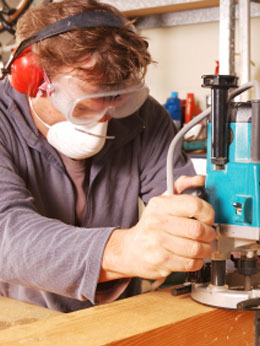Occupational Health Monitoring
KD Environmental's occupational and workplace monitoring services allows your business to protect employee health and well being. We can help to ensure you are compliant with Employer and Workplace legislation. Improving workplace conditions through diagnostics and recommendations from sick building monitoring will lead to improved employee productivity, less sick days, more vibrant and energetic staff.
Occupational Air Monitoring
Total Inhalable and Respirable Dust
Employees operating in areas of excessive ambient dust can experience health effects such as lung capacity deterioration and other such ailments. For this reason dust concentrations should be monitored to ensure either they are in compliance with maximum dust concentrations as required under Irish legislation, or that in areas of high dust concentrations personnel face masks are supplied to the employees.
Inhalable dust is taken to mean any solid particle which by its small size can be carried in airflow or remains airborne. It includes Respirable dust.
Respirable dust is taken to be the solid particles of less than 8.5 microns in size. Dust of this size is normally invisible to the human eye. Respirable dust can get deep into the lung and does not get ejected by the normal means of breathing out, coughing or travelling out in the mucus. It is because of this ability to stay in the body it is considered dangerous.
The National Authority for Occupational Safety and Health, 2007 Code of Practice for the Safety, Health and Welfare at Work (Chemical Agents) Regulations, 8-hour TWA limit for Total Inhalable Particulates is set at 10.0 mg/m3
The National Authority for Occupational Safety and Health, 2007 Code of Practice for the Safety, Health and Welfare at Work (Chemical Agents) Regulations, 8-hour TWA limit for Respirable Particulates is set at 4.0 mg/m3.
Crystalline Silica
Crystalline silica is widely found in nature. Occupational exposure to crystalline silica dust occurs in many industries including: quarrying, mining, mineral processing, construction and demolition work. Where concrete, stone or sand based materials are used, there is potential for exposure to crystalline silica dust.
Inhalation of fine dust containing crystalline silica can cause lung damage (silicosis), which in severe cases can be disabling, or even fatal. Silicosis is irreversible and treatment options are limited. Workers may develop any of three types of silicosis, depending on the concentration of airborne silica:Chronic silicosis,Accelerated silicosis or acute silicosis.
The respirable fraction of the dust is invisibly fine and the OELV for Respirable Crystalline Silica(RCS) is 0.1mg/m3 averaged over 8 hours as set down in the H.S.A. Chemical Agents Code of Practice.
Employees operating in areas of excessive ambient dust can experience health effects such as lung capacity deterioration and other such ailments. For this reason dust concentrations should be monitored to ensure either they are in compliance with maximum dust concentrations as required under Irish legislation, or that in areas of high dust concentrations personnel face masks are supplied to the employees.
Inhalable dust is taken to mean any solid particle which by its small size can be carried in airflow or remains airborne. It includes Respirable dust.
Respirable dust is taken to be the solid particles of less than 8.5 microns in size. Dust of this size is normally invisible to the human eye. Respirable dust can get deep into the lung and does not get ejected by the normal means of breathing out, coughing or travelling out in the mucus. It is because of this ability to stay in the body it is considered dangerous.
The National Authority for Occupational Safety and Health, 2007 Code of Practice for the Safety, Health and Welfare at Work (Chemical Agents) Regulations, 8-hour TWA limit for Total Inhalable Particulates is set at 10.0 mg/m3
The National Authority for Occupational Safety and Health, 2007 Code of Practice for the Safety, Health and Welfare at Work (Chemical Agents) Regulations, 8-hour TWA limit for Respirable Particulates is set at 4.0 mg/m3.
Crystalline Silica
Crystalline silica is widely found in nature. Occupational exposure to crystalline silica dust occurs in many industries including: quarrying, mining, mineral processing, construction and demolition work. Where concrete, stone or sand based materials are used, there is potential for exposure to crystalline silica dust.
Inhalation of fine dust containing crystalline silica can cause lung damage (silicosis), which in severe cases can be disabling, or even fatal. Silicosis is irreversible and treatment options are limited. Workers may develop any of three types of silicosis, depending on the concentration of airborne silica:Chronic silicosis,Accelerated silicosis or acute silicosis.
The respirable fraction of the dust is invisibly fine and the OELV for Respirable Crystalline Silica(RCS) is 0.1mg/m3 averaged over 8 hours as set down in the H.S.A. Chemical Agents Code of Practice.
Occupational Noise Monitoring
An occupational noise survey is carried out in accordance with Chapter 1 of Part 5 of the Safety, Health and Welfare at Work (General Application) Regulations 2007 and the guidance provided in HSE “Controlling Noise at Work, The Control of Noise at Work Regulations” 2005 (Ref. L108). Chapter 1 of Part 5 applies to activities where employees are likely to be exposed to noise which could pose a risk to safety and health and in particular pose a risk to hearing. Exposure Limit Values and Exposure Action Values are outlined in these Regulations.
1. Exposure limit values: Lex, 8hr = 87 dB(A) and Ppeak = 140 dB(C) in relation to 20 uPa;
2. Upper exposure action values: Lex, 8hr = 85 dB(A) and Ppeak = 137 dB(C) in relation to 20 uPa;
3. Lower exposure action values: Lex, 8hr = 80 dB(A) and Ppeak = 135 dB(C) in relation to 20 uPa;
If occupational noise levels are below the lower exposure action value no further action is required.
If noise levels are above the lower exposure action value the employer must supply adequate hearing protection is worn, noise reduction programs are in place and inform employees of risk/need to wear hearing protection.
If noise levels are above the upper exposure action value the employer must supply and ensure that adequate hearing protection is worn, noise reduction programs are in place, signage and inform employees of risk.
If noise levels are above the exposure limit value the employer must delimit areas, signage in place, control access to areas, supply and ensure that adequate hearing protection is worn, noise reduction programs are in place, signage and inform employees of risk.
Sick Building Syndrome (SBS)
Almost everyone occasionally feels unwell because they are suffering from one or more common symptoms of discomfort such as headaches, dry throat or sore eyes. But there are occasions when, for no obvious reasons, people working in particular buildings experience these sorts of symptoms more often than is usual. The symptoms tend to increase in severity with time spent in the building and improve over time or disappear away from the building. This is often described as Sick Building Syndrome.
The main symptoms associated with Sick Building Syndrome are: dry or itchy skin or skin rash; dry or itchy eyes, nose or throat; headaches, lethargy, irritability, or poor concentration, stuffy or runny nose. The symptoms are often mild and do not appear to cause any lasting damage. To those suffering, however, they are not trivial and can cause considerable distress. In severe cases, they can affect attitudes to work and may represent a significant cost to business in the form of:
Reduced staff efficiency, increased absenteeism and staff turnover, extended breaks and reduced overtime, lost time complaining and dealing with complaints.
What causes sick building syndrome?
Physical or environmental factors i.e physical working conditions such as ventilation, humidity, biological agents, temperature and CO2 levels.
Vibration Exposure Monitoring
Whole Body Vibration (WBV) monitoring
Whole-body vibration is caused by machines or vehicles that transmit vibration through the operator’s feet, buttocks and back into his or her body. These include excavators, wheel loaders, caterpillars, graders, scrapers, site dumpers, articulated dump trucks, wheeled (motor) scrapers and fork-lift trucks used on uneven terrain. Employees who are regularly exposed to whole-body vibration may suffer from lower back pain as well as disorders of the sensory functions or fine motor co-ordination. Factors such as twisting the body in constrained seated postures or exposing the spine to shocks or impact loads while using a vibrating machine place extra strain upon the spine
Under 2004/44/EC the daily Exposure Action Value (EAV) for whole body vibration is 0.5 m/s2. Above this level the employer should take action to control or reduce exposure. The daily Exposure Limit Value (ELV) for whole body vibration is 1.15 m/s2. No employee should be exposed to daily vibration above this level over a working day.
Hand Arm Vibration (HAV) monitoring
Hand-Arm Vibration is caused by vibration transmitted into the hand and arms through the palms and fingers. Common sources of vibration are hand held power tools. Workers whose hands are regularly exposed to hand-arm vibration may suffer from damage to the tissues of the hands and arms, which cause the syndrome commonly known as harm-arm vibration syndrome.
Symptoms of this syndrome include vascular disorders (white or dead finger), neurological disorders (constant tingling of fingers, hands or arms) and musculoskeletal disorders.
Under 2004/44/EC the daily Exposure Action Value (EAV) for hand-arm vibration is 2.5 m/s2. Above this level the employer should take action to control or reduce exposure. The daily Exposure Limit Value (ELV) for hand-arm vibration is 5 m/s2. No employee should be exposed to daily vibration above this level over a working day.
Whole-body vibration is caused by machines or vehicles that transmit vibration through the operator’s feet, buttocks and back into his or her body. These include excavators, wheel loaders, caterpillars, graders, scrapers, site dumpers, articulated dump trucks, wheeled (motor) scrapers and fork-lift trucks used on uneven terrain. Employees who are regularly exposed to whole-body vibration may suffer from lower back pain as well as disorders of the sensory functions or fine motor co-ordination. Factors such as twisting the body in constrained seated postures or exposing the spine to shocks or impact loads while using a vibrating machine place extra strain upon the spine
Under 2004/44/EC the daily Exposure Action Value (EAV) for whole body vibration is 0.5 m/s2. Above this level the employer should take action to control or reduce exposure. The daily Exposure Limit Value (ELV) for whole body vibration is 1.15 m/s2. No employee should be exposed to daily vibration above this level over a working day.
Hand Arm Vibration (HAV) monitoring
Hand-Arm Vibration is caused by vibration transmitted into the hand and arms through the palms and fingers. Common sources of vibration are hand held power tools. Workers whose hands are regularly exposed to hand-arm vibration may suffer from damage to the tissues of the hands and arms, which cause the syndrome commonly known as harm-arm vibration syndrome.
Symptoms of this syndrome include vascular disorders (white or dead finger), neurological disorders (constant tingling of fingers, hands or arms) and musculoskeletal disorders.
Under 2004/44/EC the daily Exposure Action Value (EAV) for hand-arm vibration is 2.5 m/s2. Above this level the employer should take action to control or reduce exposure. The daily Exposure Limit Value (ELV) for hand-arm vibration is 5 m/s2. No employee should be exposed to daily vibration above this level over a working day.


